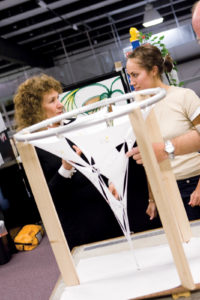Cynthia Thompson leverages her creative instincts to build a flourishing tension fabric structures business.
“Business owners need to be inventive and fast moving and I think we’ve gotten sluggish,” says Cynthia Thompson, founder and owner of Transformit in Gorham, Maine. “I think we’re looking to creative people to put the juice back into our world.” Thompson, who launched her interior tension fabric structures business 20 years ago, is intimately acquainted with the challenges of taking those creative juices and using them to make a living—to supply her personal needs, and as the business grew, to contribute to the local, national and world economy as well.
Thompson uses creative approach to business

Although Thompson did not approach the inception of Transformit with a business plan, a business degree or a detailed budget, the company—and Thompson—has a record that speaks of viability and success. She refers to “A Whole New Mind” by Daniel H. Pink to explain her approach to business. “The future belongs to a different kind of person with a different kind of mind: designers, inventors, teachers, storytellers—creative and empathetic ‘right-brain’ thinkers whose abilities mark the fault line between who gets ahead and who doesn’t,” writes Pink (page1). Though “A Whole New Mind” was published almost 20 years after Thompson founded Transformit, the book echoes her philosophy on business and life—design and creativity often embody success and are, according to Pink, the way of the future.
When Thompson started the business, few artists had preceded her in establishing art-based businesses, and banks were not receptive to her requests for financing. She had a Master of Fine Arts degree in sculpture, but no formal business training. She persisted without financing, and as her reputation grew, so did Transformit. 1996 was a banner year of notable projects, including one she did for the Olympics and one for the White House. “After that, the bank said ‘I guess you can make a living,’” Thompson remembers. “And they gave me a loan.”
For Thompson, a right-brained approach has kept her business on the cutting edge. During a presentation she made at the Institute for Civic Leadership last winter, an audience member asked her how she kept up with the latest trends. “I don’t,” Thompson said. “If you’re following the trends, you’re too late.”
In the early years of Transformit, Thompson installed a 400-foot piece constructed of spandex over an outdoor fountain for an arts festival in Portland, Maine. “My mom stood on the sidelines watching me install it, thinking I would drown underneath the structure,” Thompson says. “But I completed the installation—after a lot of struggle and getting dumped in the pond.” Then she stood in awe watching the spandex fill with air, droplets of water darkening the multi-colored fabric. The fabric floated upward 60 feet, deflated and floated up again as if it were inhaling and exhaling the Portland air. “I didn’t know it was going to do that,” she says.
Thompson thrives on challenging jobs
 The experience of taking on a large project like that and choosing spandex for an outdoor application, was just one step on the way to even more substantial projects with challenging applications. Thompson thrives on taking the jobs no one else will. “We take the jobs that are unique, or will bring us intellectual property,” Thompson says. “That is our niche—design and creativity.” Currently, Thompson and Transformit are working on several large architectural projects including one for the new Dallas Cowboys Stadium. The project will be installed in the VIP lounge and incorporates large lighting elements that are tension fabric structures. “That’s where we really shine,” she says. “Doing something different.”
The experience of taking on a large project like that and choosing spandex for an outdoor application, was just one step on the way to even more substantial projects with challenging applications. Thompson thrives on taking the jobs no one else will. “We take the jobs that are unique, or will bring us intellectual property,” Thompson says. “That is our niche—design and creativity.” Currently, Thompson and Transformit are working on several large architectural projects including one for the new Dallas Cowboys Stadium. The project will be installed in the VIP lounge and incorporates large lighting elements that are tension fabric structures. “That’s where we really shine,” she says. “Doing something different.”
Doing something different comes naturally to Thompson, who grew up in rural Indiana where no one really talked about being an artist, she says. She didn’t have the benefit of an artistic mentor so she found her own version of one—at the library in Indianapolis. As a teen, Thompson drove herself to the city to explore the world via the public library. She wandered between the shelves of hardbound books and found herself drawn to one particular volume with a vivid, primary striped shirt on the cover. The book was about Picasso. “I had never even heard of him,” she says. After that, she often escaped to the library for clandestine meetings with Picasso. “I felt like I’d practiced being an artist all my life but nobody labeled me that way,” Thompson says. “I was a foreign object to my family in the sixties in Indiana.”
Thompson’s roots contribute to her work ethic
 What she did experience in rural Indiana was a deep and profound work ethic, which no doubt contributed to her ability to create a thriving business. “My father and grandfather owned their own businesses and got up at four in the morning, went to work, and worked hard at what they did,” Thompson says. “So I learned that when you have your own business you do that.”
What she did experience in rural Indiana was a deep and profound work ethic, which no doubt contributed to her ability to create a thriving business. “My father and grandfather owned their own businesses and got up at four in the morning, went to work, and worked hard at what they did,” Thompson says. “So I learned that when you have your own business you do that.”
That attitude toward work, passed on to her by her family, was never more evident to Thompson than it was two weeks after 9/11. Thompson was scheduled to fly to Holland to install a project and was concerned about the safety of flying. She shared her apprehension with her mother, now 85, who lives with Thompson. Her mother’s six-word response was all Thompson needed to hear: “Go. That’s where the work is.”
Sigrid Tornquist is the editor of Specialty Fabrics Review.
 TEXTILES.ORG
TEXTILES.ORG


